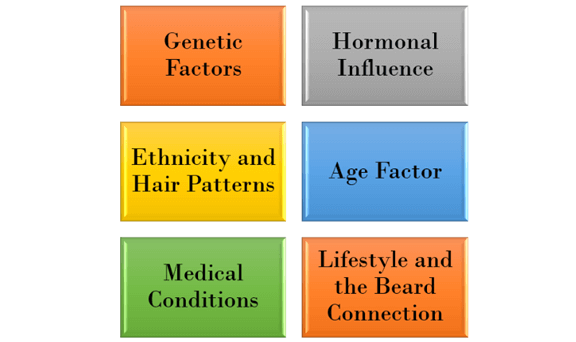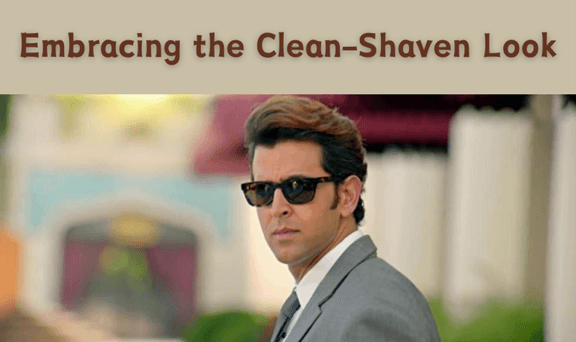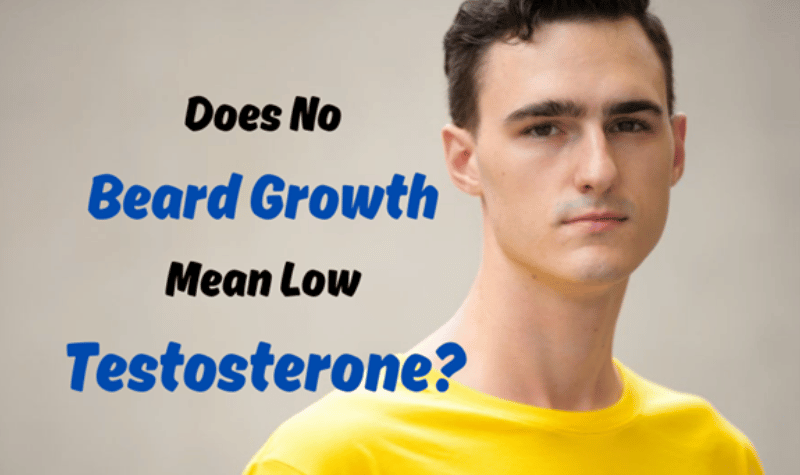Since I got many queries about “Does no beard growth mean low testosterone?” I decided to write a detailed article about this. Let’s dive deep into it.
In their desire for a strong beard, many men question whether a lack of growth signifies low testosterone level. The reality, however, is more complex than a simple yes or no. Look at the appealing world of beard growth and how it relates to testosterone.
The relationship between beard growth and testosterone is often discussed. While testosterone plays an important role in facial hair production, it is not the only factor. Many variables influence beard growth, including genetics, age, and general health.
Contrary to widespread belief, a lack of beard growth does not always indicate low testosterone. For example, genetics may have a considerable impact on beard patterns. Some men naturally have less facial hair, which is not proof of a problem with their testosterone levels.
Beard growth is a complicated process controlled by a variety of variables. Hormones like testosterone undoubtedly have an impact, but they do not explain the whole story. It’s important to understand that every man’s beard journey is unique, and a lack of growth isn’t necessarily a reason for concern.
While testosterone aids in beard growth, exploring other factors like genetic issues, hormonal influence, hairy patterns, age factors, medical conditions, and your lifestyle in this hairy story is critical. A sparse beard does not always signify low testosterone levels, as genetics and general health play equally important roles in the facial hair game.
Does No Beard Growth Mean Low Testosterone?
6 Reasons Why Your Beard is Not Growing
Genetic Factors:
One of the main reasons your beard isn’t growing as quickly as you’d want is genetic. The thickness, pattern, and growth rate of your facial hair are all determined by your genetic composition inherited from your family.
Think about your genes the architectural plan for your beard. You may have similar difficulties if your close relatives, such as your father or grandpa, suffer from minimal facial hair. On the other hand, if your family has thick beards, you’re more likely to grow one as well.
It’s important to realize that although genetics provide the foundation, they’re not the only element determining beard growth. Other factors include hormonal balance, age, diet, lifestyle, and skincare.
Understanding the genetic element helps you to go into your beard thrills with reasonable expectations. Accept your unique genetic profile and remember that a well-groomed and kept beard may be just as effective as a larger one. By accepting and working with your natural predispositions, you may still grow a beard that complements and improves your own style.

Hormonal Influence:
Another crucial factor influencing beard growth is hormonal influence, namely the effect of testosterone. Testosterone, the principal male sex hormone, influences various masculine features, including facial hair growth.
During puberty, an increase in testosterone levels causes the development of secondary sexual traits such as voice deepening, muscular growth, and the start of facial hair growth. Beard follicles react to a testosterone derivative called dihydrotestosterone (DHT), which causes facial hair to develop.
However, it is important to note that low testosterone is not necessarily the major cause of a lack of beard growth. While hormone imbalances can worsen beard-related issues, genetics, lifestyle choices, and individual differences all play important roles.
Maintaining hormonal balance via a healthy lifestyle, which includes constant exercise and a good diet, may help with beard growth. Those with chronic problems may benefit from consulting with a healthcare practitioner to examine their hormone levels.
Knowing the complex interaction between hormones and beard growth reveals the diverse nature of this process. Men may better manage their beard growth journey by taking a comprehensive strategy that considers various elements.
Ethnicity and Hair Patterns:
Various factors may impact beard growth, with ethnicity and hair patterns being two of the most important. Genetic factors may cause variances in beard development among people of various ethnicities.
Genetics influence the thickness and development rate of facial hair. Some ethnicities are genetically predisposed to abundant and rapid beard development, whilst others may have slower or less dense growth patterns. This does not imply that people of specific races cannot grow beards; nonetheless, they may observe variances in the development process.
Furthermore, the pattern of facial hair development is unique to each individual. Some people have full and well distributed facial hair, while others have patchy growth. Hair growth patterns are often inherited and may be affected by hormone levels and age.
Understanding your ethnic heritage and family’s usual hair growth patterns will help you predict your own beard growth potential. Your beard will develop at best according to your genetic composition if you take care of your health generally and groom yourself well. But there are certain things you can’t change.
The Age Factor:
As men start the adventure of beard growth, they discover the subtle effect of age on the development and look of facial hair. The age factor is important in influencing the quality and pattern of beard development since each stage of life has distinct obstacles and possibilities.
During puberty, hormonal changes, notably increased testosterone, initiate beard development. This stage is highlighted by the growth of facial hair, which is generally dispersed and uneven. Patience is required as the beard progressively fills out throughout the teenage years.
Many men experience faster beard growth throughout their early twenties when their hormone levels are regulated. The beard becomes more distinct and thicker. People enjoy their newfound freedom to shape their facial hair, so they often experiment with different beard styles.
As men enter their thirties and beyond, their beard growth may subtly vary. Some may see a thicker, more mature beard, while others may perceive a loss in density.
Understanding the age-related intricacies of beard growth allows people to adjust their grooming practices and expectations appropriately. Embracing the progression of one’s beard throughout various life stages enables a happy connection with facial hair over time.
Underlying Medical Conditions:
If your beard growth seems to have halted, you should explore any underlying medical issues that may be interfering with the process. Certain health conditions may affect hormonal balance, vitamin absorption, and general well-being, influencing facial hair development and quality.
Hormonal abnormalities like thyroid issues or low testosterone levels may hinder beard evolution. The thyroid, a tiny gland in your neck, controls various biological activities, including metabolism and hormone synthesis. Any interruption in thyroid function might lead to unsuitable circumstances for beard growth.
Although it is not the only issue, low testosterone levels may affect facial hair development. Testosterone is a major hormone involved in the growth of male secondary sexual traits, such as facial hair. However, it is crucial to note that not all cases of slow beard development are caused by low testosterone since hereditary and individual differences also play a major impact.
In rare situations, dietary shortages, such as low vitamin or mineral levels, may limit beard growth. Sufficient nourishment is required for healthy hair follicles, and shortages may lead to scant or slow-growing facial hair.
You should contact a healthcare expert if you suspect an underlying medical problem. They may do tests, evaluate your general health, and advise you on treating any possible medical issues impacting your beard development. Taking a comprehensive approach to your health may lead to a healthier, stronger beard over time.
Lifestyle and the Beard Connection:
Your everyday lifestyle decisions influence the health and development of your beard. Beyond genetics and ethnicity, lifestyle variables have a vital role in the lushness and thickness of your facial hair.
Dietary Habits:
The meals you eat have a direct impact on the health of your beard. A diet of critical minerals, vitamins, and proteins improves hair development. Make sure your meals include a mix of fruits, veggies, lean meats, and entire grains.
Hydration Matters:
Dehydration can stop beard growth. Water is essential for general health, including the function of your hair follicles. Drink plenty of water throughout the day; it should become second nature.
Stress Management:
Chronic stress may disrupt hormonal equilibrium, possibly resulting in hair loss or slowed beard growth. Incorporate stress-relieving activities such as meditation, exercise, and hobbies into your daily routine.
Adequate Sleep:
Quality sleep allows your body to rejuvenate and fix. Lack of sleep may impact hormone levels, especially testosterone, which is necessary for beard development. Strive for 7-9 hours of constant sleep every night.
Avoiding Harmful Substances:
Smoking and heavy alcohol use might have a detrimental influence on hair growth. These drugs may interfere with hormonal balance and the passage of nutrients to hair follicles.
By taking a comprehensive approach to your lifestyle, including addressing eating choices, keeping hydrated, managing stress, prioritizing sleep, and avoiding dangerous drugs, you can empower your body to encourage ideal beard growth. These lifestyle changes and good maintenance provide an ideal environment for a healthy beard.
Beard Worries in the Dating Scene: Embracing the Clean-Shaven Look

In the broad terrain of dating preferences, the issue of bearded vs. clean-shaven faces has sparked various responses. It is important to dispel common misunderstandings about beard appearance and recognize that individual tastes differ greatly. While some people like the rustic charm of a beard, others prefer a clean-shaven appearance. The goal is to embrace one’s natural style and recognize that beauty goes beyond facial hair.
Debunking Beard Attractiveness Myths: Some Prefer Smooth!
Contrary to common assumption, not everyone believes that a beard equals masculinity or beauty. According to research, individual tastes are important in dating dynamics.
Some individuals like the clean-shaven look associated with a polished and well-groomed appearance. Understanding that beauty is subjective encourages people to confidently approach the dating environment, regardless of their facial hair style.
Boosting Confidence with or Without a Beard
In the dating scene, confidence is a powerful magnetic force. Whether wearing a beard or shaving cleanly, confidence in one’s unique style may greatly influence dating success. Embracing one’s originality and feeling happy in one’s skin, with or without facial hair, radiates confidence, which might appeal to prospective mates.
The Role of Grooming: Elevating Personal Presentation
Regular grooming techniques, which include more than simply maintaining facial hair, play an important part in personal presentation and beauty. Whether one chooses a beautifully manicured beard or a clean-shaven appearance, these choices demonstrate a dedication to self-care and meticulousness.
For many, grooming practices expand beyond the face to include other elements of personal hygiene, such as back shaving. While not usually publicly mentioned, back grooming may be part of a person’s grooming routine, demonstrating their commitment to general cleanliness and grooming standards.
Furthermore, grooming behaviors might indirectly impact testosterone levels and confidence. According to research, following grooming practices, such as reducing face and body hair, may help to boost confidence and well-being. Furthermore, when paired with a healthy lifestyle, some hygiene practices may boost natural testosterone levels, increasing confidence and self-esteem.
Men who value grooming frequently radiate an appealing atmosphere of confidence and care while courting. These elements may boost one’s dating attractiveness, whether it’s confidence from grooming or subtle signs of cleanliness and attention to detail.
Frequently Asked Questions about Beard Growth

If I can’t grow a beard, does it mean I have low testosterone levels?
The inability to grow a beard is not primarily due to insufficient testosterone. While testosterone promotes beard development, additional factors such as genetics, age, and general health also play a role. Consultation with a healthcare practitioner might give tailored information.
What age does a beard reach full growth?
Beard growth varies but often peaks in the late 20s and early 30s. Some men may continue to grow even into their forties. Every person’s timeline is special, so patience’s important.
What proportion of males cannot grow a beard?
Approximately 5-10% of males may have reduced beard development owing to genetic causes. However, numerous circumstances come into play, and being unable to grow a beard does not always hurt health.
Which ethnicity cannot develop facial hair?
Facial hair growth patterns differ across ethnicities. While some people have minimal facial hair, attributing it simply to ethnicity simplifies a complicated interaction of heredity and hormones.
Is there a circumstance in which you cannot grow a beard?
Certain disorders, such as alopecia areata, may result in hair loss, including facial hair. Consulting a healthcare practitioner may assist in determining the underlying reasons and possible therapies.
Conclusion:
Finally, knowing how beards grow and their relationship with testosterone is like to solving a hard jigsaw. While testosterone is important, it is wrong to assume that not growing a beard indicates everyone has low testosterone levels. Genetics, age, and overall health are all important considerations.
The fundamental concept is to accept who you are. People generally believe that growing a huge beard makes you macho. However, this is not true for everyone. Beards aren’t for everyone, and that’s OK since every person’s physique is unique.
Feeling good about yourself, whether you have a beard or not, is essential. Everyone is unique, and your physical appearance does not just determine your worth. Whether you have a full beard, a little facial hair, or none, confidence comes from embracing who you are.
This article also discusses the importance of maintaining good overall health. Instead of focusing just on your appearance, consider your overall wellness. Eating correctly, exercising, and controlling stress are important for your general health and promoting facial hair growth.
Learning to embrace oneself entails acknowledging that there is no single way to be beautiful. Regardless of your beard status, celebrating who you are fosters a more positive and inclusive view of beauty. The basic objective is prioritizing your pleasure and well-being above striving to match society’s expectations. Thanks for reading. If you want to share a story or some advice, feel free to leave your comment below, but for now, be safe and have fun.!


